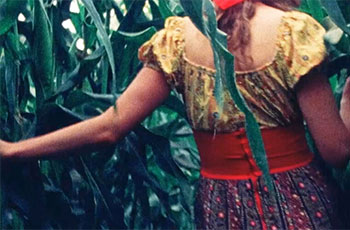
Martin Scorsese created the World Cinema Project (WCP) in 2007 recognizing the urgent need to preserve, restore, and provide access to films from around the world. To date, 70 films from Africa, Asia, Eastern Europe, Central America, South America, and the Middle East have been restored, preserved, and exhibited for global audiences. As part of the WCP, the African Film Heritage Project (AFHP) was launched in 2017 in partnership with the Pan African Federation of Filmmakers (FEPACI) and UNESCO, in collaboration with Cineteca di Bologna, to preserve the legacy of African cinema. The WCP also supports Restoration Film Schools, intensive, results-oriented workshops allowing students and professionals to learn the art and science of film restoration and preservation. Titles are available for exhibition rental by clicking "Book This Film."
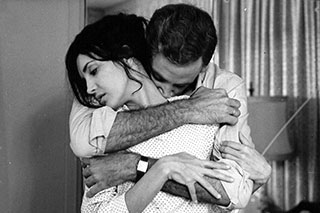
MEMORIES OF UNDERDEVELOPMENT
MEMORIAS DEL SUBDESARROLLO
Director: Tomás Gutiérrez Alea
WRITTEN BY: Tomás Gutiérrez Alea
EDITING: Nelson Rodríguez
DIRECTOR OF PHOTOGRAPHY: Ramón F. Suárez
PRODUCER: Miguel Mendoza
STARRING: Sergio Corrieri (Sergio Carmona Mendoyo), Daisy Granados (Elena), Eslinda Núñez (Noemi), Omar Valdés (Pablo), René de la Cruz (Elena’s brother)
COUNTRY OF PRODUCTION: Cuba
LANGUAGE: Castilian with English an French subtitles
COLOR INFO: Black and White
RUNNING TIME: 97 minutes
PRODUCTION COMPANY: Instituto Cubano del Arte e Industria Cinematograficos (ICAIC)
PRODUCER: Miguel Mendoza
Restored by Cineteca di Bologna at L’Immagine Ritrovata laboratory in association with Instituto Cubano del Arte e Industria Cinematográficos (ICAIC). Restoration funded by The George Lucas Family Foundation and The Film Foundation’s World Cinema Project.
I remember it as if it were yesterday. The film begins. A dizzying sound of drumbeats invades the movie theatre. Pulsating bodies take the screen. Dozens, hundreds of people, mostly blacks and mestizos, are dancing. Everything is movement and ecstasy. All of a sudden, gunshots ring out. A man lies on the ground - a lifeless body. Surrounding him, the deafening music and the rhythm continue. The beat is frenzied. The camera travels from face to face in the crowd until it stops at a young black woman. The frame freezes on her trance-lit face.
Thus begins Memorias del subdesarrollo, and watching it was like a shock to me. The film navigated between different states - fiction and documentary, past and present, Africa and Europe. The dialectic narrative took the form of a collage, crafted with an uncommon conceptual and cinematographic rigor. Scenes from newsreels, historical fragments and magazine headlines mixed and collided. In Memorias del subdesarrollo, Alea proved that filmic precision and radical experimentation could go hand in hand. Nothing was random. Each image echoing in the following image, the whole greater than the sum of its parts. Until then, having spent part of my childhood in Europe, I had a better knowledge of Italian neorealism and the French new wave than I did of the cinematic currents in Latin America. I admired Rossellini and Visconti and the early films of Godard and Truffaut - and with good reason. On taking the camera to the streets and showing the faces and lives of ordinary people, the neorealists and the directors of the nouvelle vague had fomented a true ethical and aesthetic revolution in films.
But Memorias del subdesarrollo carried with it something more. A point of view that was vigorous, original and, more importantly, pertained directly to us, Latin Americans. It was like a reverse angle - one that seemed more resonant to me than that which was prevalent in other latitudes.
- Walter Salles
I remember that soon after the Revolution, everybody (and I mean everybody) thought that our island could be transformed, from one moment to the next, into a sort of Switzerland of the Caribbean. We had everything we needed: the people, the weapons, the enthusiasm, and the opportunity to re-build our country from scratch. Only later did we understand that we were basically a farming country, that industrialization would take more time than we had hoped, and that our island was small, poor and underdeveloped. All of a sudden, everything that had once seemed within arm’s reach was further and further away. The new reality is a radical one. We don’t just need a new economy, new politics, a new society. We need a new way of thinking, and this will take longer. For now, we have to accept who we are and keep fighting, which brings me back to the concept of underdevelopment, but this time, of a moral and aesthetic nature.
Every day, to build our society, we have to confront the type of people we despise: those who think they are the only custodians of the Revolution, who believe only they know socialist morality, and who have institutionalized mediocrity and provincialism. The bureaucrats, with or without a desk, who talk to our people as one does with children, telling us what to show them, how to address them. And since these bureaucrats believe that our people are not ready to know the whole truth, they are ashamed of them, and suffer from a national inferiority complex. I hope, with my film, to annoy, provoke and upset all of them.
- Tomás Gutiérrez Alea
NOTES ON THE RESTORATION:
The restoration of Memorias del Subdesarrollo was made possible through the use of the original camera and sound negative and a vintage duplicate positive provided and preserved by ICAIC.
The camera negative is affected overall by advanced vinegar syndrome – in particular where the duplicate negatives of archival footage are edited into the film – causing a consistent ‘halo’ on the image. Most of reel 3 was irreversibly crystallized and half of reel 4 was badly compromised by decay. The duplicate element was used to replace the image in those portions. The camera negative was scanned at 4K, using wet-gate only for the most problematic sections.
The dual bilateral variable area sound negative showed a poor photographic definition, resulting in a harsh and raspy sound, with noticeable image spread distortion. Scratches, dirt and dust on the emulsion caused heavy crackles and clicks during reproduction. Sound restoration was able to reduce these issues considerably.

ELOQUENT PEASANT, THE
SHAKAVI EL FLASH EL FASI
Director: Shadi Abdel Salam
WRITTEN BY: Shadi Abdel Salam
EDITING: Kamal Abou El Ella
STARRING: Ahmed Marei (Peasant); Ahmed Enan (The Great Stewart); Ahmed Hegazi (Thutenakht)
COUNTRY OF PRODUCTION: Egypt
LANGUAGE: Arabic
COLOR INFO: Color
RUNNING TIME: 21 minutes
Restored in 2010 by Cineteca di Bologna/L’Immagine Ritrovata laboratory, in association with The Film Foundation’s World Cinema Project, and the Egyptian Film Center. Restoration funded by Armani, Cartier, Qatar Airways and Qatar Museum Authority.
Based on one of the major literary texts survived from the Middle Kingdom, the classical period of Egyptian literature, The Eloquent Peasant is a combination of a morality/folk tale and a poem. The events are set between 2160 and 2025 BC. When the peasant Khun-anup and his donkey stumble upon the lands of the noble Rensi, the peasant’s goods are confiscated and he’s unjustly accused of theft. The peasant petitions Rensi who is so taken by the peasant’s eloquence that he report his astonishing discovery to the king. The king realises the peasant has been wronged but delays judgement so as to he can hear more of his eloquence. The peasant makes a total of nine petitions until finally, his goods are returned.
NOTES ON THE RESTORATION:
The Eloquent Peasant has been restored using the original 35mm camera and sound negatives preserved at the Egyptian Film Center in Giza. The digital restoration produced a new 35 mm internegative. Special thanks to the Bibliotheca Alexandrina.
Image: © Courtesy of Egyptian Film Centre
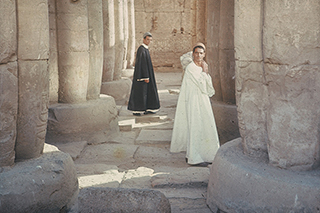
AL MOMIA
NIGHT OF COUNTING THE YEARS, THE
Director: Shadi Abdel Salam
WRITTEN BY: Shadi Abdel Salam
EDITING: Kamal Abou El Ella
DIRECTOR OF PHOTOGRAPHY: Abdel Aziz Fahmi
MUSICAL DIRECTOR: Mario Nascimbene
FROM: Egyptian Film Centre
STARRING: Ahmed Marei (Wannis), Ahmed Hegazi (Brother), Zouzou Hamdi El Hakim (Mother), Nadia Lofti (Zeena)
COUNTRY OF PRODUCTION: Egypt
LANGUAGE: Arabic with French and English subtitles
COLOR INFO: Color
RUNNING TIME: 103 minutes
PRODUCTION COMPANY: Egyptian General Cinema Organization
SET DESIGNER: Salah Marei
Restored in 2009 by Cineteca di Bologna/L’Immagine Ritrovata laboratory, in association with The Film Foundation’s World Cinema Project, and the Egyptian Film Center. Restoration funded by Armani, Cartier, Qatar Airways, Qatar Museum Authority and the Egyptian Ministry of Culture.
Momia, which is commonly and rightfully acknowledged as one of the greatest Egyptian films ever made, is based on a true story: in 1881, precious objects from the Tanite dynasty started turning up for sale, and it was discovered that the Horabat tribe had been secretly raiding the tombs of the Pharaohs in Thebes. A rich theme, and an astonishing piece of cinema. The picture was extremely difficult to see from the 70s onward. I managed to screen a 16mm print which, like all the prints I’ve seen since, had gone magenta. Yet I still found it an entrancing and oddly moving experience, as did many others. I remember that Michael Powell was a great admirer. Momia has an extremely unusual tone – stately, poetic, with a powerful grasp of time and the sadness it carries. The carefully measured pace, the almost ceremonial movement of the camera, the desolate settings, the classical Arabic spoken on the soundtrack, the unsettling score by the great Italian composer Mario Nascimbene – they all work in perfect harmony and contribute to the feeling of fateful inevitability. Past and present, desecration and veneration, the urge to conquer death and the acceptance that we, and all we know, will turn to dust… a seemingly massive theme that the director, Shadi Abdel Salam, somehow manages to address, even emobody with his images. Are we obliged to plunder our heritage and everything our ancestors have held sacred in order to sustain ourselves for the present and the future? What exactly is our debt to the past? The picture has a sense of history like no other, and it’s not at all surprising that Roberto Rossellini agreed to lend his name to the project after reading the script. And in the end, the film is strangely, even hauntingly consoling – the eternal burial, the final understanding of who and what we are… am very excited that Shadi Abdel Salam’s masterpiece has been restored to original splendor.
–Martin Scorsese, May 2009
NOTES ON THE RESTORATION:
The restoration of Al Momia used the original 35mm camera and sound negatives preserved at the Egyptian Film Center in Giza. The digital restoration produced a new 35mm internegative. The film was restored with the support the Egyptian Ministry of Culture.
Image: © Courtesy of Egyptian Film Centre
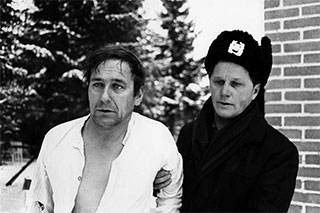
EIGHT DEADLY SHOTS
KAHDEKSAN SURMANLUOTIA
Director: Mikko Niskanen
WRITTEN BY: Mikko Niskanen
DIRECTOR OF PHOTOGRAPHY: Mikko Niskanen
STARRING: Tarja-Tuulikki Tarsala, Mikko Niskanen, Paavo Pentikäinen, Tauno Paananen. Elina Liimatainen, Ari Vainiontaus, Mauno Argillander, Sulo Hokkanen
COUNTRY OF PRODUCTION: Finland
LANGUAGE: Finnish with English subtitles
COLOR INFO: Black and White
RUNNING TIME: 316 minutes
Restored by The Film Foundation's World Cinema Project, Yleisradio Oy, Fiction Finland ry, and Fondazione Cineteca di Bologna at L'Immagine Ritrovata laboratory. Funding provided by the Hobson/Lucas Family Foundation. Additional support provided by The Ministry of Culture and Education in Finland, Tiina and Antti Herlin Foundation, and the Jane and Aatos Erkko Foundation.
NOTES ON THE RESTORATION:
EIGHT DEADLY SHOTS was originally broadcast in Finland as a 4-part television series by the national public broadcasting company of Finland, YLE. The late film historian and filmmaker Peter von Bagh first discovered and disseminated the work of Mikko Niskanen and was a tireless advocate for this film's restoration. Due to von Bagh's championing, Niskanen is recognized as one of Finland's most revered auteurs.
The digital restoration was completed using a 4K scan of the original 16mm one perforation A/B roll negatives preserved by Yleisradio Oy.
In addition to digital restoration, and in order to be as faithful as possible to the original 16mm look and texture, a new fine grain was created and used to generate a duplicate negative. Finally, two new 35mm prints were struck for circulation and preservation.
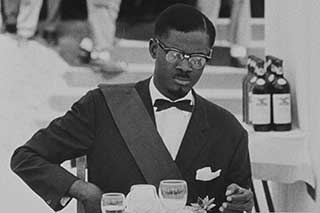
LUMUMBA, DEATH OF A PROPHET
LUMUMBA, LA MORT DU PROPHÈTE
Director: Raoul Peck
WRITTEN BY: Raoul Peck
COUNTRY OF PRODUCTION: France
LANGUAGE: French with English subtitles
COLOR INFO: Color/Black and White
RUNNING TIME: 69 minutes
PRODUCTION COMPANY: Velvet Film
Restored by The Film Foundation’s World Cinema Project and Cineteca di Bologna at L’Immagine Ritrovata/L’Image Retrouvée in collaboration with Velvet Film and supervised by Raoul Peck.
Funding provided by the Hobson/Lucas Family Foundation.
This restoration is part of the African Film Heritage Project, an initiative created by The Film Foundation’s World Cinema Project, the Pan African Federation of Filmmakers and UNESCO – in collaboration with Cineteca di Bologna – to help locate, restore, and disseminate African cinema.
NOTES ON THE RESTORATION:
LUMUMBA, DEATH OF A PROPHET was restored in 4K using the original 16mm camera and sound negatives.

MORTU NEGA
Director: Flora Gomes
WRITTEN BY: Manuel Rambout Barcelos, Flora Gomes, David Lang
EDITING: Christiane Lack
DIRECTOR OF PHOTOGRAPHY: Dominique Gentil
PRODUCER: Maria Cecilia Fonseca
SOUND: José da Silva Carvalho
STARRING: Bia Gomes, Tunu Eugenio Almada, Mamadu Uri Balde, Pedro da Silva, Flora Gomes, Homna Nalete, M'Male Nhasse
COUNTRY OF PRODUCTION: Guinea-Bissau
LANGUAGE: Kriolu, Portuguese
COLOR INFO: Color
RUNNING TIME: 96 minutes
PRODUCER: Maria Cecilia Fonseca
Restored by The Film Foundation’s World Cinema Project and Cineteca di Bologna at L’Immagine Ritrovata laboratory in association with Flora Gomes. Funding provided by the Hobson/Lucas Family Foundation.
This restoration is part of the African Film Heritage Project, an initiative created by The Film Foundation’s World Cinema Project, the Pan African Federation of Filmmakers and UNESCO – in collaboration with Cineteca di Bologna – to help locate, restore, and disseminate African cinema.
NOTES ON THE RESTORATION:
MORTU NEGA was restored in 4K from the original super 16mm camera negative and 35mm magnetic sound, stored at LTC Laboratoires. Color grading was supervised by Dominique Gentil and Flora Gomes. Special thanks to Arsenal – Institut für Film und Videokunst.

O REGRESSO DE AMÍLCAR CABRAL
Director: Sana Na N'Hada, José Bolama, Josefina Crato, Djalma Fettermann, Flora Gomes
COUNTRY OF PRODUCTION: Guinea-Bissau
LANGUAGE: Portuguese, Guinea-Bissau Creole, Mandika, French
COLOR INFO: Color
Restored by The Film Foundation’s World Cinema Project and Cineteca di Bologna at L’Immagine Ritrovata laboratory in association with Cooperativa de Produçao Cinematografica e Audiovisual GEBA FILMES. Funding provided by the Hobson/Lucas Family Foundation.
This restoration is part of the African Film Heritage Project, an initiative created by The Film Foundation’s World Cinema Project, the Pan African Federation of Filmmakers and UNESCO – in collaboration with Cineteca di Bologna – to help locate, restore, and disseminate African cinema.
NOTES ON THE RESTORATION:
O REGRESSO DE AMÍLCAR CABRAL was restored in 4K from a 16mm color reversal print and the original 16mm soundtrack negative, preserved at the Svenska Filminstitutet. Color grading was supervised by Flora Gomes and Sana na N'HADA. Special thanks to Arsenal – Institut für Film und Videokunst.

TWO GIRLS ON THE STREET
KÉT LÁNY AZ UTCÁN
Director: André De Toth
WRITTEN BY: Tamás Emod, Rezsö Török
EDITING: Zoltán Kerényi
DIRECTOR OF PHOTOGRAPHY: Károly Vass
ADAPTED BY: André De Toth
PRODUCER: Béla Lévay
FROM: Hungarian National Film Archive
PRODUCTION DESIGN: Gizella Langermann
STARRING: Bella Bordy (Torma Vica), Mária Tasnádi Fekete (Kártély Gyöngyi), Piroska Vaszary Pletyus (as Vaszary Piri), Gyula Csortos (Filc bácsi), Andor Ajtay, Csiszár István, Károly Kovács, Lali
COUNTRY OF PRODUCTION: Hungary
LANGUAGE: Hungarian with French and English subtitles
COLOR INFO: Black and White
RUNNING TIME: 85 minutes
PRODUCTION COMPANY: Hunnia Filmgyár
PRODUCER: Béla Lévay
Restored in 2010 by Cineteca di Bologna/L'Immagine Ritrovata laboratory, in association with The Film Foundation’s World Cinema Project and Magyar Nemzeti Filmarchívum. Restoration funded by Armani, Cartier, Qatar Airways and Qatar Museum Authority.
André De Toth was a great filmmaker, we are indebted to him for a number of extraordinary films (dating back to his first Hungarian works) and many masterpieces. He fought to make ambitious films and refused to work under a studio contract, thus showing a rare desire for freedom […] One day, following a screening of Round Midnight, De Toth told me, “You made me cry. And it’s hard to cry when you only have one eye.” He comforted and supported me. He was never bitter, he would never have said something like: “Cinema was better when I was making films”. He remained curious, open-minded; he battled for the American Cinematheque on Hollywood Boulevard […] “We’re like passengers driving at full speed on the new highways of communication”, he wrote. “It’s the same road since 1895, only it’s slippier because of the sweat and the blood and with more cracks: each of them a broken dream. These past hundred years have been terrible, yet we’ve enjoyed every single minute of them. As long as this fever, this love for making films survives, nothing will ever change.” On his sets, one big sign read, “Drama should occur in front of the camera, not behind it”, another, “Technology will never replace brains and intelligence”.
(Bertrand Tavernier)
NOTES ON THE RESTORATION:
The restoration of Két Lány Az Utcán used the original 35mm camera and sound nitrate negatives preserved at the Magyar Nemzeti Filmarchívum (Hungarian National Film Archive). The digital restoration produced a new 35mm internegative.
Image: © Courtesy of Magyar Nemzeti Filmarchívum (Hungarian National Film Archive)
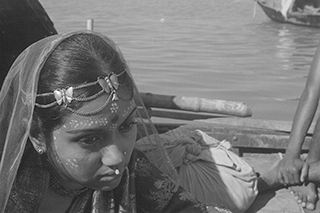
River Called Titas, A
TITAS EKTI NADIR NAAM
Director: Ritwik Ghatak
WRITTEN BY: Advaita Malla Burman, Ritwik Ghatak
EDITING: Basheer Hussain
DIRECTOR OF PHOTOGRAPHY: Baby Islam
PRODUCER: Habibur Rahman Khan
MUSICAL DIRECTOR: Ustad Bahadur Khan
STARRING: Kabari Choudhury (Rajar Jhi), Roushan Jamil (Mother), Probir Mitra (Kishore), Ritwik Ghatak (Tilakchand), Rani Sarkar (Mungli), Sufia Rustam (Udaytara), Rosi Smad (Basanti)
COUNTRY OF PRODUCTION: India
LANGUAGE: Bengali with French/English subtitles
COLOR INFO: Black and White
RUNNING TIME: 158 minutes
ON COMPANY: Ribatan Ghatak/Ritwik Memorial Trust; National Film Archive of India; Bundesarchiv-Filmarchiv
PRODUCER: Habibur Rahman Khan
Restored in 2010 by Cineteca di Bologna /L’Immagine Ritrovata laboratory, in association with Ritwik Memorial Trust, the National Film Archive of India, and The Film Foundation’s World Cinema Project. Additional film elements provided by the Bundesarchiv-Filmarchiv. Restoration funded by Doha Film Institute.
If you were eighteen years old, growing up in New Delhi, a student of cinema, a cinephile or a plain film snob, it was given that you would swoon over the film-maker Ritwik Ghatak and spend endless hours in the Delhi University canteen discussing his films, his alcoholism, and his eventual death from Tuberculosis. An ‘avant garde’ Writer and Director, Ghatak had caught the imagination of many of us who carried Mao’s Red Book’ and quoted liberally from it (in English) at the drop of a hat. After all, didn’t Ghatak (a card carrying Communist) film the extreme poverty and the cultural extinction of Bengal by Imperialism? Because of the political ‘din’ surrounding much of Ghatak’s work, ironically the work itself, as opposed to the man’s personality and politics, got neglected by the legion of his die-hard fans (me included!). It was only years later when I saw his epic, A River Called Titas, that I swooned for totally different reasons. The film is a work of pure genius. A passionate elegy for a dying culture, it moved me profoundly, and continues to haunt me to this day. Based on a novel by the Bengali author Advaita Barman and adapted for the screen by Ghatak, A River Called Titas, tells the raw and powerful story of a dying river and a dying culture.
–Deepa Mehta, May 2010
NOTES ON THE RESTORATION:
The restoration of A River called Titas used the camera and sound negatives and a positive print provided by the Ritwik Memorial Trust and held at the National Film Archive of India. As the original negative is incomplete and some reels were severely damaged, a combined lavender and a positive print provided by the Bundesarchiv-Filmarchiv were also used. The digital restoration produced a new 35 mm internegative.
Image: © Courtesy of Ritaban Ghatak - Ritwik Memorial Trust
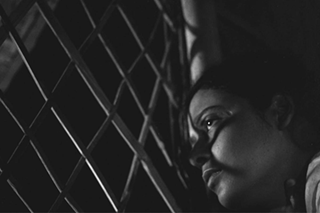
CLOUD-CAPPED STAR, THE
MEGHE DHAKA TARA
Director: Ritwik Ghatak
WRITTEN BY: Ritwik Ghatak
EDITING: Ramesh Joshi
DIRECTOR OF PHOTOGRAPHY: Dinen Gupta
PRODUCER: Ritwik Ghatak
ART DIRECTOR: Ravi Chatterjee
STARRING: Supriya Choudhury, Anil Chatterjee, Bijon Bhattacharya, Gita De, Gita Ghatak, Dwiju Bhawal, Niranjan Roy
COUNTRY OF PRODUCTION: India
LANGUAGE: Bengali
COLOR INFO: Black and White
RUNNING TIME: 127 minutes
PRODUCER: Ritwik Ghatak
Restored by the Criterion Collection in cooperation with The Film Foundation’s World Cinema Project and the Cineteca di Bologna.
NOTES ON THE RESTORATION:
A new digital transfer was created from the 35 mm original camera negative, preserved at the National Film Archive of India in Pune. This element includes several shots inserted from a duplicate negative. A 35 mm print from the Library of Congress was used for sections of the film where the original camera negative was damaged or incomplete.
The original monaural soundtrack was remastered from the Library of Congress’s print and a digital source from the British Film Institute
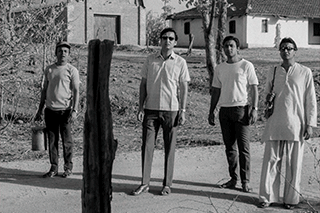
DAYS AND NIGHTS IN THE FOREST
ARANYER DIN RATRI
Director: Satyajit Ray
WRITTEN BY: Satyajit Ray
EDITING: Dulal Dutta
DIRECTOR OF PHOTOGRAPHY: Soumendu Roy
ADAPTED BY: Satyajit Ray
PRODUCER: Asim Dutta, Nepal Dutta
STARRING: Sharmila Tagore, Kaberi Bose, Simi Garewal, Soumitra Chatterjee, Subhendu Chatterjee, Rabi Ghosh, Samit Bhanja
COUNTRY OF PRODUCTION: India
LANGUAGE: Bengali with English subtitles
COLOR INFO: Black and White
RUNNING TIME: 117 minutes
PRODUCER: Asim Dutta, Nepal Dutta
Restored by The Film Foundation’s World Cinema Project at L’Immagine Ritrovata in collaboration with Film Heritage Foundation, Janus Films, and the Criterion Collection. Funding provided by the Golden Globe Foundation.
Special thanks to Wes Anderson.
NOTES ON THE RESTORATION:
Aranyer Din Ratri was restored in 4K at L'Immagine Ritrovata using the original camera and sound negative preserved by Purnima Dutta, and magnetic track preserved at the BFI National Archive. Special thanks to Sandip Ray.

GHATASHRADDHA
Director: Girish Kasaravalli
WRITTEN BY: Girish Kasaravalli, K.V. Subanna
EDITING: Umesh Kulkarni
DIRECTOR OF PHOTOGRAPHY: S. Ramachandra
STARRING: Narayan Bhatt, Ramaswamy Iyengar, Janganath, Ajith Kumar, Shanta Kumari, Meena Kuttappa, Ramakrishna, Suresh
COUNTRY OF PRODUCTION: India
LANGUAGE: Kannada
COLOR INFO: B&W
RUNNING TIME: 115 minutes
Restored by The Film Foundation’s World Cinema Project and Film Heritage Foundation at L’Immagine Ritrovata laboratory in association with Girish Kasaravalli. Funding provided by the Hobson/Lucas Family Foundation.
NOTES ON THE RESTORATION:
Restored using the 35mm original camera negative preserved at the NFDC-National Film Archive of India and a 35mm print preserved at the Library of Congress.
